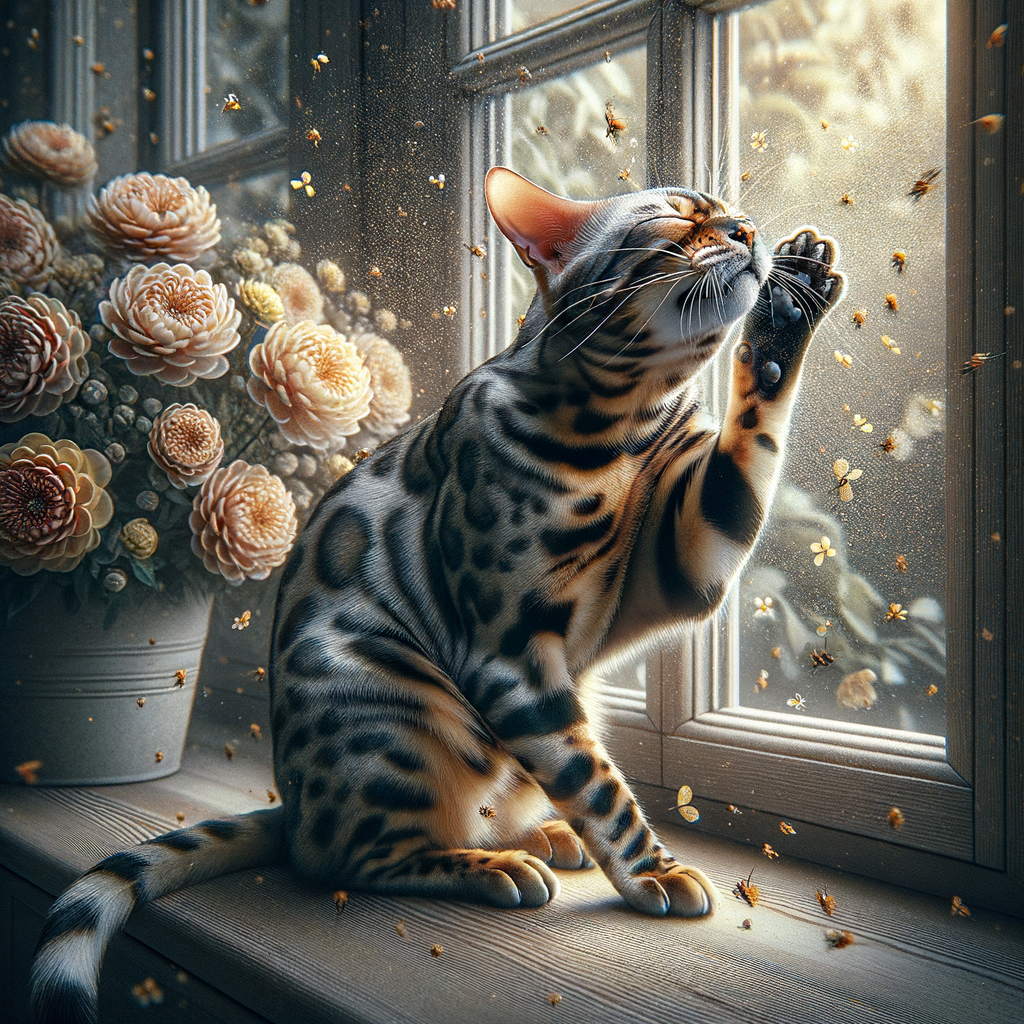
Introduction to Seasonal Allergies in Bengal Cats
Seasonal allergies can affect our pets just like they affect us. Bengal cats, known for their beautiful coats and playful nature, are no exception. Understanding these allergies can help you keep your Bengal cat healthy and happy.
- The concept of seasonal allergies: Seasonal allergies happen when your cat’s immune system reacts to something in the environment. This could be pollen, mold, or dust. These allergens are more common in certain seasons, like spring or fall.
- Why Bengal cats are prone to seasonal allergies: Bengal cats have a unique genetic makeup that can make them more sensitive to allergens. Their short, dense fur can trap pollen and other particles close to their skin, causing irritation. Additionally, their active lifestyle means they are more likely to come into contact with allergens.
Recognizing Bengal Cat Allergy Symptoms
-
Common signs of allergies in Bengal cats
- Itching and Scratching: Your cat may scratch more than usual.
- Red or Inflamed Skin: Look for redness or swelling on their skin.
- Hair Loss: Cats might lose patches of fur due to excessive scratching.
- Runny Nose and Eyes: Just like humans, cats can have watery eyes and a runny nose.
- Frequent Sneezing: If your cat sneezes a lot, it could be a sign of allergies.
- Ear Infections: Check for frequent ear infections or head shaking.
-
Distinguishing between seasonal and non-seasonal allergies
- Seasonal Allergies: These occur at certain times of the year. For example, your cat might have symptoms in spring or fall when pollen levels are high.
- Non-Seasonal Allergies: These can happen any time of the year. They might be caused by things like dust, mold, or certain foods.
Managing Allergies in Bengal Cats
Identifying Common Allergens for Bengal Cats
Allergies in Bengal cats can be triggered by various factors. Knowing what these allergens are can help you manage and reduce your cat’s discomfort.
- Outdoor allergens: These are allergens your Bengal cat can encounter outside the home.
- Pollen: Trees, grasses, and weeds release pollen, which can cause allergic reactions.
- Mold: Mold spores from damp areas can be a significant allergen.
- Dust: Outdoor dust can carry various allergens that affect your cat.
- Indoor allergens: These are allergens found inside your home.
- Dust mites: Tiny creatures that live in household dust can cause allergies.
- Household cleaners: Some cleaning products contain chemicals that can irritate your cat.
- Pet dander: Skin flakes from other pets can also be an allergen.
Preventing Exposure to Allergens
- Effective Cleaning Practices: Regularly vacuum carpets, rugs, and furniture. Use a vacuum with a HEPA filter to trap tiny particles. Mop floors with a damp mop to pick up dust and dander. Wash your cat’s bedding weekly in hot water to kill dust mites.
- Choosing Hypoallergenic Products: Select products that are less likely to cause allergic reactions. Use hypoallergenic cat litter to minimize dust. Choose cleaning products labeled as hypoallergenic. These products have fewer chemicals and fragrances that can irritate your cat’s skin and respiratory system.
Bengal Cat Seasonal Allergy Treatment
Medical Treatments
Antihistamines
Antihistamines can help reduce allergy symptoms in Bengal cats. These medications work by blocking histamines, which cause itching and sneezing. Consult your vet before giving any antihistamines to ensure the correct dosage and type.
Common antihistamines include:
- Diphenhydramine (Benadryl)
- Chlorpheniramine
Steroids
Steroids are another option for treating severe allergies in Bengal cats. They reduce inflammation and provide quick relief from itching and swelling. However, steroids should be used cautiously due to potential side effects.
Types of steroids include:
- Prednisone
- Dexamethasone
Natural Remedies
-
Supplements for Allergy Relief
Supplements can help Bengal cats with allergies. Omega-3 fatty acids are one example. They reduce inflammation and improve skin health. You can find Omega-3s in fish oil or flaxseed oil.
Another helpful supplement is quercetin. It is a natural antihistamine. Quercetin can be found in apples and berries. It helps reduce itching and swelling.
Probiotics are also beneficial. They boost the immune system. A strong immune system can fight off allergens better. You can add probiotics to your cat’s diet through yogurt or special supplements.
-
Home Remedies for Allergy Relief
Home remedies can also help your Bengal cat. One simple remedy is regular bathing. Bathing removes allergens from the fur. Use a gentle, hypoallergenic shampoo for best results.
Another home remedy is using a humidifier. Dry air can worsen allergy symptoms. A humidifier adds moisture to the air. This can help your cat breathe easier.
Dust and pollen can collect on surfaces. Vacuum carpets and wash bedding regularly. This reduces the allergens your cat is exposed to.
Bengal Cat Skin Allergies
Causes of Skin Allergies
- Environmental factors: Bengal cats can be sensitive to their surroundings. Common allergens include pollen, dust mites, and mold. For instance, during spring, pollen levels rise, which can trigger skin reactions in Bengal cats. Dust mites, often found in household items like carpets and bedding, can also cause issues.
- Dietary factors: Food allergies are another common cause. Ingredients like beef, dairy, and fish can sometimes trigger allergic reactions. It’s essential to monitor your Bengal cat’s diet and note any changes in their skin condition when introducing new foods.
Preventing and Treating Skin Allergies
- Importance of Regular Grooming: It helps remove dirt, dead skin, and loose fur. This can prevent skin irritations and allergies. Brushing your cat’s fur at least once a week can make a big difference.Grooming also allows you to check for signs of allergies. Look for red spots, bumps, or excessive scratching. If you notice any of these, it might be time to visit the vet.
- Choosing the Right Diet: Some cats are allergic to certain foods. Common allergens include dairy, beef, and fish. Switching to a hypoallergenic diet can help.Consult your vet to find the best diet for your cat. They might recommend a special food that avoids common allergens. Always introduce new foods slowly to avoid upsetting your cat’s stomach.
Addressing Bengal Cat Respiratory Allergies
Common Symptoms
Respiratory allergies in Bengal cats can be concerning. Knowing the signs can help you act quickly.
- Signs of respiratory distress: Watch for symptoms like coughing, wheezing, or difficulty breathing. Your cat might also have a runny nose or watery eyes. These signs can indicate that your cat is struggling to breathe properly.
- When to seek veterinary care: If you notice any of these symptoms, contact your vet right away. Early treatment can prevent more serious health issues. Your vet can provide the best advice and treatment options for your Bengal cat.
Treatment Options
- Medication options:There are several medications available to help Bengal cats with respiratory allergies. Antihistamines can reduce symptoms like sneezing and itching. Steroids may also be prescribed by your vet to reduce inflammation. Always consult your vet before giving any medication to your cat.For example, Benadryl is a common antihistamine that can be used, but the dosage must be carefully determined by a vet. Steroids like prednisone can be effective but should be used under strict veterinary supervision due to potential side effects.
- Environmental modifications:Making changes to your cat’s environment can greatly reduce allergy symptoms. Keep your home clean by vacuuming regularly and using air purifiers to remove allergens from the air. Washing your cat’s bedding frequently can also help.For instance, using HEPA filters in your home can trap airborne particles that may cause allergies. Additionally, keeping windows closed during high pollen seasons can prevent outdoor allergens from entering your home.
Allergy Relief for Bengal Cats: Key Takeaways
- Importance of early detection: Identifying allergies in Bengal cats early can make a big difference. Early detection helps in managing symptoms before they become severe. Watch for signs like sneezing, itching, or watery eyes. The sooner you notice, the quicker you can help your cat feel better.
- Role of regular veterinary check-ups: Vets can spot allergies that you might miss. They can also suggest the best treatments and preventive measures. Make sure to schedule check-ups at least once a year, or more often if your cat has known allergies.
Bengal Cat Allergy Prevention
- Importance of Prevention Over Treatment
Preventing allergies in Bengal cats is better than treating them. It’s easier and less stressful for both you and your cat. By focusing on prevention, you can avoid the discomfort and health issues that come with allergies.
- Creating a Safe and Healthy Environment for Your Bengal Cat
To keep your Bengal cat healthy, make sure their environment is clean and allergen-free. Regularly clean their bedding, toys, and litter box. Use air purifiers to reduce airborne allergens. Feed them a balanced diet to boost their immune system.






